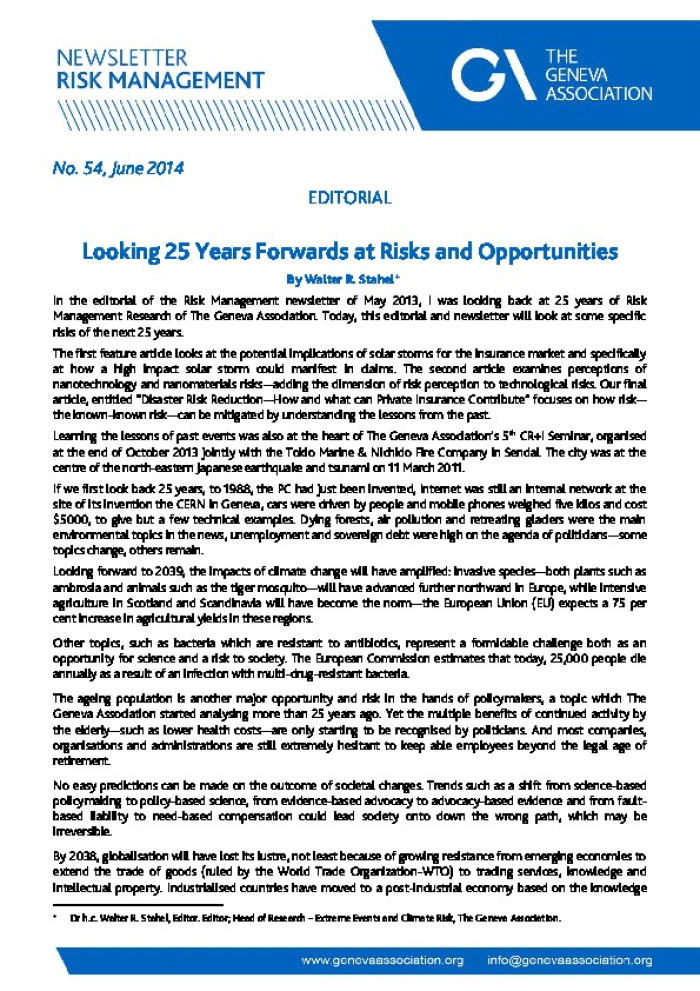Looking 25 Years Forwards at Risks and Opportunities
Article from the Risk Management Newsletter No. 54: Walter R. Stahel presents the articles in this newsletter that take a closer look at the role of insurance with regard to current emerging risks and opportunities

No. 54, June 2014 EDITORIAL Looking 25 Years Forwards at Risks and Opportunities By Walter R. Stahel+ In the editorial of the Risk Management newsletter of May 2013, I was looking back at 25 years of Risk Management Research of The Geneva Association. Today, this editorial and newsletter will look at some specific risks of the next 25 years. The first fea ture article looks at the potential implications of solar storms for the insurance market and specifically at how a high impact solar storm could manifest in claims. The second article examines perceptions of nanotechnology and nanomaterials risks ?adding t he dimension of risk perception to technological risks. Our final article, entitled ?Disaster Risk Reduction ?How and what can Private Insurance Contribute? focuses on how risk ? the known -known risk ?can be mitigated by understanding the lessons from the past. Learning the lessons of past events was also at the heart of The Geneva Association?s 5 th CR+I Seminar, organised at the end of October 2013 jointly with the Tokio Marine & Nichido Fire Company in Sendai. The city was at the centre of the north -eastern Japanese earthquake and tsunami on 11 March 2011. If we first look back 25 years, to 1988, the PC had just been invented, Internet was still an internal network at the site of its invention the CERN in Geneva, cars were driven by people and mobile phones weighed five kilos and cost $5000, to give but a few technical examples. Dying forests, air pollution and retreating glaciers were the main environmental topics in the news, unemployment and sovereign debt were high on the agenda of politicians ?some topics change, others remain. Looking forward to 2039, the impacts of climate change will have amplified: invasive species ?both plants such as ambrosia and animals such as the tiger mosquito ?will have advanced further northward in Europe, while intensive agriculture in Scotland and Scandinavia will have become the norm ?the European Union (EU) expects a 75 per cent increase in agricultural yields in these regions. Other topics, such as bacteria which are resistant to antibiotics, represent a formidable challenge both as an opportunity for science and a risk to society. The European Commission estimates that today, 25,000 people die annually as a result of an infection with multi -drug -resistant bacteria. The ageing population is another major opportunity and risk in the hands of policymakers, a topic which The Geneva Association started analysing more than 25 years ago. Yet the multiple benefits of continued activity by the elderly ?such as lower health costs ?are only starting to be recognised by politicians. And most companies, organisations and administrations are still extremely hesitant to keep able employees beyond the legal age of retirement. No easy predictions can be made on the outcome of societal changes. Trends such as a shift from science -based policymaking to policy -based science, from evidence- based advocacy to advocacy-based evidence and from fault - based liability to need -based compensation could lead society onto down the wrong path, which ma y be irreversible. By 2038, globalisation will have lost its lustre, not least because of growing resistance from emerging economies to extend the trade of goods (ruled by the World Trade Organization -WTO) to trading services, knowledge and intellectual p roperty. Industrialised countries have moved to a post -industrial economy based on the knowledge + Dr h.c. Walter R. Stahel, Editor. Editor; Head of Research ? Extreme Events and Climate Risk , The Geneva Association.